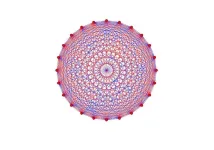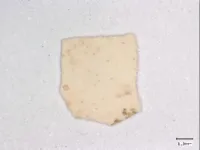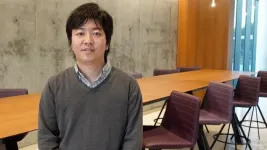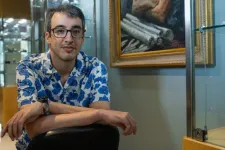(Press-News.org) We’ve all been there: staring at a math test with a problem that seems impossible to solve. What if finding the solution to a problem took almost a century? For mathematicians who dabble in Ramsey theory, this is very much the case. In fact, little progress had been made in solving Ramsey problems since the 1930s.
Now, University of California San Diego researchers Jacques Verstraete and Sam Mattheus have found the answer to r(4,t), a longstanding Ramsey problem that has perplexed the math world for decades.
What was Ramsey’s problem, anyway?
In mathematical parlance, a graph is a series of points and the lines in between those points. Ramsey theory suggests that if the graph is large enough, you’re guaranteed to find some kind of order within it — either a set of points with no lines between them or a set of points with all possible lines between them (these sets are called “cliques”). This is written as r(s,t) where s are the points with lines and t are the points without lines.
To those of us who don’t deal in graph theory, the most well-known Ramsey problem, r(3,3), is sometimes called “the theorem on friends and strangers” and is explained by way of a party: in a group of six people, you will find at least three people who all know each other or three people who all don’t know each other. The answer to r(3,3) is six.
“It’s a fact of nature, an absolute truth,” Verstraete states. “It doesn't matter what the situation is or which six people you pick — you will find three people who all know each other or three people who all don't know each other. You may be able to find more, but you are guaranteed that there will be at least three in one clique or the other.”
What happened after mathematicians found that r(3,3) = 6? Naturally, they wanted to know r(4,4), r(5,5), and r(4,t) where the number of points that are not connected is variable. The solution to r(4,4) is 18 and is proved using a theorem created by Paul Erdös and George Szekeres in the 1930s.
Currently r(5,5) is still unknown.
A good problem fights back
Why is something so simple to state so hard to solve? It turns out to be more complicated than it appears. Let’s say you knew the solution to r(5,5) was somewhere between 40-50. If you started with 45 points, there would be more than 10234 graphs to consider!
“Because these numbers are so notoriously difficult to find, mathematicians look for estimations,” Verstraete explained. “This is what Sam and I have achieved in our recent work. How do we find not the exact answer, but the best estimates for what these Ramsey numbers might be?”
Math students learn about Ramsey problems early on, so r(4,t) has been on Verstraete’s radar for most of his professional career. In fact, he first saw the problem in print in Erdös on Graphs: His Legacy of Unsolved Problems, written by two UC San Diego professors, Fan Chung and the late Ron Graham. The problem is a conjecture from Erdös, who offered $250 to the first person who could solve it.
“Many people have thought about r(4,t) — it’s been an open problem for over 90 years,” Verstraete said. “But it wasn’t something that was at the forefront of my research. Everybody knows it's hard and everyone’s tried to figure it out, so unless you have a new idea, you’re not likely to get anywhere.”
Then about four years ago, Verstraete was working on a different Ramsey problem with a mathematician at the University of Illinois-Chicago, Dhruv Mubayi. Together they discovered that pseudorandom graphs could advance the current knowledge on these old problems.
In 1937, Erdös discovered that using random graphs could give good lower bounds on Ramsey problems. What Verstraete and Mubayi discovered was that sampling from pseudorandom graphs frequently gives better bounds on Ramsey numbers than random graphs. These bounds — upper and lower limits on the possible answer — tightened the range of estimations they could make. In other words, they were getting closer to the truth.
In 2019, to the delight of the math world, Verstraete and Mubayi used pseudorandom graphs to solve r(3,t). However, Verstraete struggled to build a pseudorandom graph that could help solve r(4,t).
He began pulling in different areas of math outside of combinatorics, including finite geometry, algebra and probability. Eventually he joined forces with Mattheus, a postdoctoral scholar in his group whose background was in finite geometry.
“It turned out that the pseudorandom graph we needed could be found in finite geometry,” Verstraete stated. “Sam was the perfect person to come along and help build what we needed.”
Once they had the pseudorandom graph in place, they still had to puzzle out several pieces of math. It took almost a year, but eventually they realized they had a solution: r(4,t) is close to a cubic function of t. If you want a party where there will always be four people who all know each other or t people who all don’t know each other, you will need roughly t3 people present. There is a small asterisk (actually an o) because, remember, this is an estimate, not an exact answer. But t3 is very close to the exact answer.
The findings are currently under review with the Annals of Mathematics.
“It really did take us years to solve,” Verstraete stated. “And there were many times where we were stuck and wondered if we’d be able to solve it at all. But one should never give up, no matter how long it takes.”
Verstraete emphasizes the importance of perseverance — something he reminds his students of often. “If you find that the problem is hard and you're stuck, that means it's a good problem. Fan Chung said a good problem fights back. You can't expect it just to reveal itself.”
Verstraete knows such dogged determination is well-rewarded: “I got a call from Fan saying she owes me $250.”
END
The math problem that took nearly a century to solve
UC San Diego mathematicians unlock the secret to Ramsey numbers
2024-04-02
ELSE PRESS RELEASES FROM THIS DATE:
When did the chicken cross the road? New evidence from Central Asia
2024-04-02
Chickens are one of the most economically important animals in the world today. However, the story of their origins and dispersal across the ancient world is still poorly understood. In fact, new archaeological techniques have recently led to the recognition that many finds of bones previously thought to represent early chickens in fact belonged to wild birds. Now, in a new publication, an international team of archaeologists, historians, and biomolecular scientists present the earliest clear evidence for the raising of chickens for egg production, and argue that the loss of seasonal egg laying was the main driver for the dispersal of domestic chickens across Eurasia and northeast Africa.
Using ...
A data representation method using distance correlation
2024-04-02
Association in-between features has been demonstrated to improve the representation ability of data. However, the original association data reconstruction method may face two issues: the dimension of reconstructed data is undoubtedly highly than that of original data, and adopted association measure method does not well balance effectiveness and efficiency.
To solve the problems, a research team led by Yuhua QIAN published their new research on 12 Mar 2024 in Frontiers of ...
Lundquist investigator Dr. Eiji Yoshihara awarded $3 million NIH R01 grant for diabetes stem cell therapy research
2024-04-02
The National Institute of Diabetes and Digestive and Kidney Diseases (NIDDK), a division of the National Institutes of Health, has granted Eiji Yoshihara, PhD, a principal investigator at The Lundquist Institute (TLI) and assistant professor at the David Geffen School of Medicine at UCLA, a five-year grant totaling $3 million. This prestigious NIH R01 grant, known for its rigorous peer-review process, is dedicated to advancing stem cell therapy research for treating diabetes.
Insulin-dependent diabetes, including autoimmune Type 1 and stress-induced Type 2, presents a significant health burden, often necessitating lifelong ...
YKT6 gene variants cause a new genetic disorder finds a new study
2024-04-02
A recent collaborative study has discovered rare variants in the YKT6 gene as the cause of a new neurological disorder characterized by developmental delays along with severe progressive liver disease and a potential risk for liver cancer. The study, published in Genetics in Medicine, was led by Dr. Hugo Bellen, Distinguished Service Professor at Baylor College of Medicine and Principal Investigator at the Jan and Dan Duncan Neurological Research Institute (Duncan NRI) at Texas Children’s Hospital, and Dr. Wendy Chung, the Chief of the Department of Pediatrics at Boston Children’s ...
Australia on track for unprecedented, decades-long megadroughts
2024-04-02
Australia could soon see megadroughts that last for more than 20 years, according to new modelling from The Australian National University (ANU) and the ARC Centre of Excellence for Climate Extremes.
The researchers’ bleak findings are before factoring in human impact on the climate since the Industrial Revolution. The ANU-led team also found that 20th century droughts in southwestern and eastern Australia, including the Murray-Darling Basin, were longer on average compared to pre-industrial times.
According to the scientists, the findings paint a worrying picture of future droughts in Australia that are far worse than anything in recent experience.
Megadroughts are exceptionally ...
Dilling named associate laboratory director for neutron sciences at ORNL
2024-04-02
Jens Dilling has been named associate laboratory director for the Neutron Sciences Directorate, or NScD, at the Department of Energy’s Oak Ridge National Laboratory, effective April 1.
“ORNL pioneered neutron scattering in the 1940s, developing a new technique that enables scientists to explore and create new materials, batteries and more,” ORNL Director Stephen Streiffer said. “Today, ORNL remains at the forefront of this science, and Jens will play a critical role in ensuring the nation's ...
UC San Diego receives $6.7M to develop whole-body inflammation imaging
2024-04-02
Researchers at University of California San Diego School of Medicine have been awarded two new grants by the National Institutes of Health (NIH), totaling $6.7 million, to develop and clinically test technologies that can noninvasively examine and quantify immune cells found in tumors. These immune cells, called macrophages, are involved in the body’s normal inflammatory responses, but they also make up a significant portion of solid tumors. The density of macrophages in a tumor can affect how it responds to treatment, so the ability to count them noninvasively could help doctors decide which therapies ...
Health care utilization is increased in high-risk children who have a sleep disorder
2024-04-01
DARIEN, IL – The risk of increased health care utilization among children with a chronic medical condition is higher for those who also have a sleep disorder, according to a new study that examined Medicaid claims data.
The study found that among children who had a chronic medical condition, those who also had a diagnosed sleep disorder were nearly two times more likely to have increased health care utilization (odds ratio = 1.83) than those who had no sleep disorder. The most common sleep disorder diagnosis was sleep-disordered breathing, which was present in 1,796 children. ...
More than 18,000 excess TB cases in the U.S. attributable to structural racism
2024-04-01
Embargoed for release until 5:00 p.m. ET on Monday 1 April 2024
Annals of Internal Medicine Tip Sheet
@Annalsofim
Below please find summaries of new articles that will be published in the next issue of Annals of Internal Medicine. The summaries are not intended to substitute for the full articles as a source of information. This information is under strict embargo and by taking it into possession, media representatives are committing to the terms of the embargo not only ...
Rice’s Mark Torres wins NSF CAREER Award to examine river water chemistry
2024-04-01
Mark Torres, assistant professor of Earth, environmental and planetary sciences at Rice University, has won a National Science Foundation (NSF) CAREER Award to unlock new insights in river water chemistry, including its implications for addressing environmental concerns.
Torres’ five-year, $612,930 grant is to develop innovative approaches for analyzing variations in river water chemistry. He will lead a research team to shed light on the interplay between water flow and chemical reactions to better understand the effects of climate change on water resources.
“The chemistry ...
LAST 30 PRESS RELEASES:
Tracing the quick synthesis of an industrially important catalyst
New software sheds light on cancer’s hidden genetic networks
UT Health San Antonio awarded $3 million in CPRIT grants to bolster cancer research and prevention efforts in South Texas
Third symposium spotlights global challenge of new contaminants in China’s fight against pollution
From straw to soil harmony: International team reveals how biochar supercharges carbon-smart farming
Myeloma: How AI is redrawing the map of cancer care
Manhattan E. Charurat, Ph.D., MHS invested as the Homer and Martha Gudelsky Distinguished Professor in Medicine at the University of Maryland School of Medicine
Insilico Medicine’s Pharma.AI Q4 Winter Launch Recap: Revolutionizing drug discovery with cutting-edge AI innovations, accelerating the path to pharmaceutical superintelligence
Nanoplastics have diet-dependent impacts on digestive system health
Brain neuron death occurs throughout life and increases with age, a natural human protein drug may halt neuron death in Alzheimer’s disease
SPIE and CLP announce the recipients of the 2025 Advanced Photonics Young Innovator Award
Lessons from the Caldor Fire’s Christmas Valley ‘Miracle’
Ant societies rose by trading individual protection for collective power
Research reveals how ancient viral DNA shapes early embryonic development
A molecular gatekeeper that controls protein synthesis
New ‘cloaking device’ concept to shield sensitive tech from magnetic fields
Researchers show impact of mountain building and climate change on alpine biodiversity
Study models the transition from Neanderthals to modern humans in Europe
University of Phoenix College of Doctoral Studies releases white paper on AI-driven skilling to reduce burnout and restore worker autonomy
AIs fail at the game of visual “telephone”
The levers for a sustainable food system
Potential changes in US homelessness by ending federal support for housing first programs
Vulnerability of large language models to prompt injection when providing medical advice
Researchers develop new system for high-energy-density, long-life, multi-electron transfer bromine-based flow batteries
Ending federal support for housing first programs could increase U.S. homelessness by 5% in one year, new JAMA study finds
New research uncovers molecular ‘safety switch’ shielding cancers from immune attack
Bacteria resisting viral infection can still sink carbon to ocean floor
Younger biological age may increase depression risk in older women during COVID-19
Bharat Innovates 2026 National Basecamp Showcases India’s Most Promising Deep-Tech Ventures
Here’s what determines whether your income level rises or falls
[Press-News.org] The math problem that took nearly a century to solveUC San Diego mathematicians unlock the secret to Ramsey numbers






